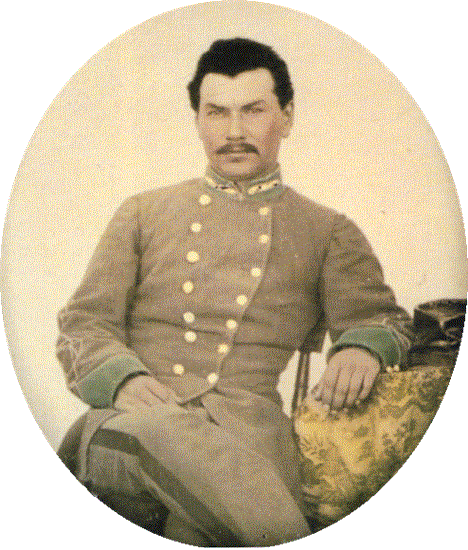 Captain Jose Rafael de la Garza was born in 1838 to a prominent and wealthy San Antonio family with deep Texas roots. Jose was well educated at St. Joseph’s College in Bardstown, Kentucky. One of his teachers described him as a young man of "fine disposition… very mild and cheerful, always in good humor and someone who never utter an improper word."
Captain Jose Rafael de la Garza was born in 1838 to a prominent and wealthy San Antonio family with deep Texas roots. Jose was well educated at St. Joseph’s College in Bardstown, Kentucky. One of his teachers described him as a young man of "fine disposition… very mild and cheerful, always in good humor and someone who never utter an improper word."
After the secession of Texas in February, 1861, Jose was one of 90,000 Texans who joined the Confederate Army, in which he was appointed captain in Company K, 6th Texas Infantry. De la Garza was later a company commander in the 17th Texas Infantry. Jose was killed leading his company in a charge against Union forces at the Battle of Mansfield, Louisiana on May 8, 1864. He was 26 years old. A letter relaying the details of his death is below.
-Compiled by the Texas Military Forces Museum
Headquarters Waul’s Brigade
Walker’s Division, in the Field
Apl. 19, 1864
Friend Bart,
Having a few leisure moments, I thought I could not better employ them than by writing you. Our command having been halted at this place to give the men an opportunity to wash and clean up generally as they have been marching and fighting for the past month without rest.
I have some painful news to communicate to you. It is that Joe Garza fell while gallantly fighting at the head of his company at the battle of Mansfield on the evening of the 8th inst. He was shot above the knee with a shell and died soon after. This I was told by a number of his company who had assisted at his burial. Joe spent the greater part of the day with me the day before the fight and was in fine health and spirits…
I have had a pretty rough and hard time since I reached this command, as it was falling back from Marksville where we were going and the Yanks pursuing. As I had to relieve the then quartermaster of this brigade and everything being in confusion, I had a pretty rough time. I did not get into the battle of the 8th, but did in the 9th. It was a hard fight, but we whipped the Yanks badly. I think it was the most complete victory of the war. We had but about 8 or 9,000 in the first day’s fight and in the second about 12,000. The enemy had not less than 30,000 in the first, and were reinforced on the second day by a fresh corps. They were completely routed, losing about 300 wagons and trains, wagons loaded with stores, between 80 and 100 ambulances, 16 pieces of artillery with everything complete. All of these fell into our hands and were saved. They also destroyed quartermaster stores without number. Small arms it would be hard to estimate numbers, as all of our gun supplies and Enfield rifles that were left on the battlefield and there were wagon loads hauled off. As far as I was able to see and could learn from the parties sent out to bury the dead, theirs was at about 5 to 1 of our dead. And hundreds were reported laying in the woods, the men not taking the trouble to bury when there were none of our men killed.
In prisoners we got between 4 and 5,000. Our loss in officers has been terribly severe. We have to mourn the loss of Major General Tom Green, Brigadier General Mouton, some 9 or 10 colonels in the same proportion. After the two days fights we were ordered on the march. Where we are going is “Quien Sabe” but am inclined to think Arkansas is the point, unless [Union general Frederick] Steele happens to fall back too rapidly that there would be no chance for us to catch him…
H.B. Adams